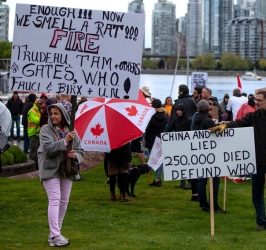10.3.2 The Contemporary Far Right
Gregory Millard
By “far right” we mean beliefs, activists, and parties that lie beyond the boundaries of mainstream conservatism on the right of the political spectrum. Before determining whether the far right is fascist, we first need to summarize its beliefs and tendencies. These can be summarized as follows:
 Figure 10.7. Defaced "Muslims Are Welcome" poster. |
Xenophobic and nativist nationalism that seeks a more culturally and ethnically homogeneous nation. National majorities must, on this view, protect their culture, identity, and integrity against perceived existential threats. Such supposed threats include immigrants, refugees, Muslims, and 2SLGBTQ+ people. Supranational entities, such as the European Union, the United Nations, and the World Economic Forum are also reviled as ‘evil outside forces’ (Muddle, 2019, p. 177) and frequently denounced as sites of conspiracies to destroy the nation’s sovereignty, identity, and values (Rydgren, 2018, p. 2). |
 Figure 10.8. COVID-19 Anti-Lockdown Protest in Vancouver, May 3rd, 2020. |
Populism. The far right condemns established political, economic, and cultural elites for systematically favouring, or else conspiring with, the above threats. Its members ‘oppose some fundamental values of liberal democracy, notably minority rights and pluralism’ (Muddle, 2019, p. 6) and often tend to regard opposition to their views as illegitimate. However, today’s far right ‘does not usually oppose democracy per se’ (Rydgren, 2018, p. 2). Rather, it is ‘typically hostile to the way existing democratic institutions actually work. In fact, radical right-wing parties argue that they represent true democracy’ (Rydgren, 2019, p. 2) by empowering the people against corrupt elites. |
 Figure 10.9. 9-11 Was an Inside Job stickers. |
Conspiratorial thinking. Established sources of knowledge and information – news media, universities, scientists, and government experts – are also perceived as controlled by corrupt ‘elites’ and cannot be trusted. The far right is therefore prone to a burgeoning array of conspiracy theories offering alternative interpretations of reality (e.g., Q-Anon, the Great Replacement, ‘Stop the Steal,’ the 15-Minute City, etc.). These usually emphasize elite collusion with forces threatening the nation. |
 Figure 10.10. Freedom Convoy 2022. |
Traditional norms and hierarchies. The far right embraces ‘culture wars’ in defence of dominant gender, familial, religious, and racialized identities within the nation. It also displays a strong ‘law and order’ orientation favouring police power and a punitive approach to crime (Muddle, 2019, p. 177), though the far right shows ‘no signs of militarism’ (Muddle, 2019, p. 184). It should be noted, however, that in recent years those on the far right, especially in America, have been prone to believing that the government ‘has already been taken over by foreign forces or is colluding with internal enemies like Jews, African Americans and/or other minorities [and that this] necessitates violence as the government is acting to enslave the general (white) population’ (Holt et al. p. 368). While broadly supportive of a punitive approach to law and order, then, members of the far right are often willing to support lawbreaking in defence of their own cause. The Freedom Convoy can be seen as a relatively mild and peaceful end of this lawbreaking militancy, with violent insurrection and domestic terrorism at the other end. |
It is probably to treat the far right as somewhat distinct from today’s right-wing populism. However, the latter clearly draws from the far-right ideas just described, even as right-wing populist politicians maintain an ambiguous relationship with more extreme activists and organizations. This affinity has led to accusations of fascism against democratically-elected leaders such as Donald Trump in the U.S., Narendra Modi in India, or Jair Bolsonaro in Brazil – not to mention Viktor Orban in Hungary and Vladimir Putin in Russia.
So, the key question is: Should today’s far right be understood as a form of fascism?
It’s complicated. According to Jens Rydgren, today’s far right differs from fascism in at least two major ways:
Using the list of core themes from fascism identified earlier in this chapter, we may add to this list of differences the following as well:
Cased closed, then? Not so fast. There are “affinities to fascism” in today’s far right (Rydgren, 2018, p. 7). A “populist ultra-nationalism” is present, though it is “less aggressive and expansive, and rather turned inward” (Rydgren, 2018, p. 7). Although lacking the totalitarian and radically transformative ambitions of fascists, contemporary right-wing populists and the far right do share with fascism a keen perception of national decline and a desire to purify and reinvigorate the national identity. They agree that established elites are corrupt and must be supplanted (by themselves). They share a proclivity for targeting vulnerable minorities – Muslims, immigrants, and refugees especially, but also 2SLGBTQ+ people – in the name of dominant identities. Finally, contemporary populists share with fascism a rather brazen disinterest in facticity and truth: their emphasis is on galvanizing, rabble-rousing rhetoric with scant regard to logical consistency or factual accuracy. Hence, some scholars, such as Timothy Snyder or Jason Stanley (2018), suggest that they can be described as fascist – and that so can right-wing populist politicians.
Given this mix of affinities and differences, we are left with a problem of judgement rather than an easy, hard-and-fast dividing line between fascism and today’s far right (see Copley, 2018, and Enzo Traverso). Are echoes of classic fascism, some familiar-seeming elements mixed with major divergences, enough to justify classifying a phenomenon as fascist? Or should we be mindful of fascism’s extreme and alarming connotations – i.e., world war and genocide – and aver that if we define fascism as interchangeable with exclusionary, illiberal populism, we drain the term of both potency and analytical value? Ultimately, we may well conclude that we are better off treating right-wing populism as a subset of populism rather than of fascism. Readers of chapter 9 Populism will observe that this is ultimately the preferred approach of this textbook.
Discussion Questions
- What might be some explanations for fascism’s explosive growth in the period between the two world wars? Do any of those same conditions seem to apply today?
- This chapter takes an equivocal – some might say wishy-washy – view of whether today’s far right is best described as fascist. What do you think? Is fascism still a relevant force in our politics, or is it best understood as largely an interwar phenomenon?
- Nazism, the far right, and contemporary authoritarian populism all share an affinity for conspiracy theories of various sorts. What, in your view, explains the appeal of such conspiracy theories? – i.e., why are certain people so drawn to them?
Media Attributions
- Pro-refugees Anti-refugees poster, Montreal, 2017 © Coastal Elite is licensed under a CC BY-SA (Attribution ShareAlike) license
- COVID-19 Anti-Lockdown Protest in Vancouver, May 3rd 2020 © GoToVan is licensed under a CC BY (Attribution) license
- 911 Inside Job Sticker © 911conspiracy is licensed under a CC BY (Attribution) license
- Freedom Convoy 2022 Ottawa February 4-11 © ΙΣΧΣΝΙΚΑ-888 is licensed under a CC BY-SA (Attribution ShareAlike) license

